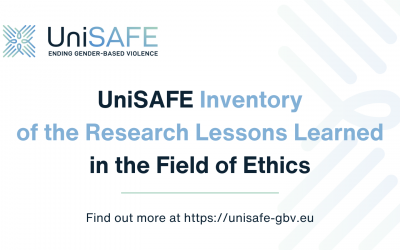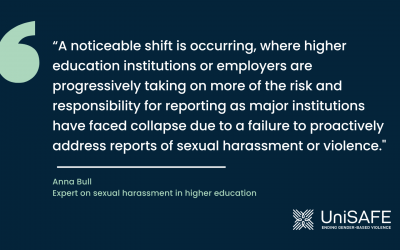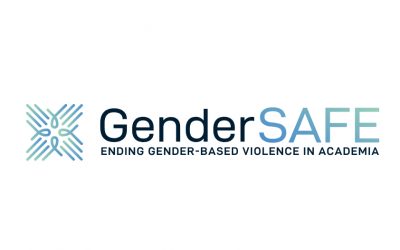The UniSAFE survey is being implemented from 17 January to end of April 2022 in 46 universities and research organisations across the EU. It questions staff and students on their experience of different forms of gender-based violence, in order to provide measurable evidence on prevalence of gender-based violence in universities and research organisations, understanding how it relates to its determinants and consequences. Dr Anke Lipinsky, from GESIS – Leibniz-Institute for the Social Sciences is responsible for the survey’s design and implementation. She presents here the UniSAFE survey’s outline and what it is aiming to achieve.
Higher education and research institutions – like all other places of social interaction – are sites of potential exposure to violence and abuse. This unpleasant reality has been investigated in numerous institutional case studies and national surveys, but never to our knowledge in a large-scale survey across multiple institutions throughout Europe.
To counteract the potential normalisation of abusive behaviour experienced by staff and students, particularly as it is often seen as taboo, it is important to shed light on this persisting issue in academia through empirical research. Only when the extent and severity of the problem are identified and fully recognised, can research institutions and all their members develop and implement effective measures. The UniSAFE survey will provide valuable data to support this, by investigating the prevalence of gender-based violence among staff and students.
The UniSAFE survey is to be among the largest of its kind
Until today, most surveys carried out in research and higher education institutions in Europe, the US, Canada or Australia have focused on sexual assaults and harassment, mobbing and, more recently, online forms of violence and misconduct (e.g. Brubaker et al 2017; Cantor et al 2020; List 2017; Zabrodska and Kveton 2013; Lombardo and Bustelo 2022; Kaasa et al 2016; AHRC 2017). Many surveys address students as group of specific vulnerability and dependence, others approach staff of different status groups, e.g. in the context of surveying the wellbeing of staff in the workplace. To develop its questionnaire, the UniSAFE’s survey team did an extensive mapping of these existing studies and questionnaires, adapting many previously tested questions from different sources and supplementing them by looking at other forms of violence taken from more general population surveys on violence.
What makes the UniSAFE survey approach unique is that the survey target group is not limited to a subgroup of staff or students in higher education and research organisations, and instead captures the experiences of all as it includes students studying at all levels and staff holding different contracts (academic and non-academic).
The online survey is to be conducted in over 45 universities and research organisations in 15 countries in Europe. The more people participate and share their experiences – whether they have experienced violence themselves or not – the more reliable and complete the picture will become of how individuals in the participating research performing organisations deal with violence.
The aims and scopes of the survey
The aim is to learn – in the context of academia rather than individual institutions – what risk factors (e.g. gender, sexual orientation, mobility) exist and contrast the experiences (modes, location, frequency) between different groups, and also the consequences that violence can have on well-being or careers/studies.
The online survey, launched in January and ending in April 2022, takes a broad approach, and investigates six different forms of violence. The questions have been adapted to fit the context of higher education and research where necessary. Another key characteristic of the online survey is that it goes beyond a binary understanding of sex and gender. By relying on a large-scale dataset, the survey will offer a unique opportunity to examine the experiences of violence among underrepresented groups of people, such as people with disabilities, transgender people or international staff and students. The survey source questionnaire is available open access in English as well as in 14 other languages.
The analysis will take into account the national and institutional characteristics of the respondents, and consider how these may shape prevalence rates for different forms of violence across different groups. The online survey is only one of the important sources of data for the analyses that make up UniSAFE’s research. Another important source of data is the institutional case studies that examine countermeasures against violence. The quantitative data from individuals and the institutional case studies will be analysed together with an assessment of the policy and legal framework. All this data, quantitative and qualitative information, feeds into the development and advancement of measures against gender-based violence in research performing organisations.
Dr Anke Lipinsky, Senior researcher at GESIS – Leibniz Institute for the Social Sciences, Department Data and Research on Society
Please note: survey respondents must work or study in a participating organisation. If you don’t, but wish to share your experience, we invite you to take part in our call for interviews which is open to researchers all over Europe.



